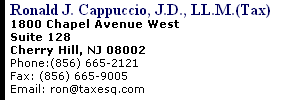|
You
may know about the 60-day window for making tax-free rollovers
of funds withdrawn from your IRA or other tax-favored
retirement account. Here are a couple of things you might not
know about the deadline:
1. The 60-day
period begins the day after you receive funds
from the account in question. That can be a beneficial
rule because every day counts. (Internal Revenue Code
Section 402(c)(3)(A))
2. Unlike
most tax-deadlines, there is no extension granted if the
rollover period ends on a weekend or holiday. So, for
example, if the 60-day period ends on a Sunday, the rollover
deadline is not extended to the following Monday.
Meeting the deadline is crucial. If you don't complete a
rollover within the 60-day window, the withdrawn amount is
treated as a taxable distribution to you as the account owner.
That is painful enough, but there's more. If this failed
rollover happens before you reach age 59 1/2, you may also get
hit with the 10 percent premature withdrawal penalty tax. That
is doubly painful. In addition, you may owe state income
tax.
Although
the 60-day rule is well-known, taxpayers still miss it all the
time for various reasons. In general, the IRS is
unsympathetic, even if you've got a fairly good excuse.
However, all may not be lost. The IRS does grant relief for
missed rollovers in a tightly defined set of circumstances.
(IRS Revenue Procedure 2003-16)
Who
Caused the Missed Deadline?
The
IRS will automatically waive the 60-day rule when a
mistake made by a financial institution causes you to miss the
deadline for making a tax-free rollover. However, an automatic
waiver is only available when you meet all the
criteria listed below:
1. The financial
institution received the funds on your behalf before the
expiration of the 60-day rollover period.
2. You gave
instructions to the financial institution that would have
resulted in a successful rollover if they had been
followed.
3. Within the
60-day period, you complied with the financial institution's
directions for accomplishing a successful rollover.
4. Only
because of one or more errors by the financial institution,
the funds were not deposited into an eligible
retirement account or plan within the 60-day rollover
period. In other words, the attempted tax-free rollover
failed, and it was the financial institution's fault while
you were essentially blameless.
5.
Last but definitely not least, you must show that the
funds you intended to roll over tax-free were actually
deposited into an eligible retirement account or plan within
one year from the beginning of the 60-day rollover
period. In other words, while you may pass all the other
tests necessary to qualify for a waiver of the 60-day rule,
you only have a limited time to prove you were absolutely
serious about wanting a tax-free rollover. Put another way,
the waiver of the 60-day rule is a limited time offer, and
you must prove your good intentions within the one-year time
frame.
Observation: At
first blush, these rules may seem almost impossible to take
advantage of, but many taxpayers can meet them. The hard part
may be proving it to the IRS. If
you qualify for relief under the automatic waiver rules, the
failed rollover will be declared a tax- free transaction after
all.
Another Option: Request a Hardship
Waiver
Even if you are ineligible for an automatic waiver, you may
still be able to get
|
What is a Private Letter
Ruling?
A
private letter ruling only applies to the
specific taxpayer who asks for the written advice. It
cannot be relied on as precedent by other taxpayers or
IRS personnel. However, the IRS publishes private letter
rulings, which taxpayers and their advisers can use as
guides to help understand how the agency thinks about a
topic. When an individual requests a ruling and pays the
$95 fee, he or she will receive a letter with a decision
and the reasons behind
it. | relief from the 60-day
rule on the grounds of hardship. This is done by
requesting a private letter ruling (PLR) from the
IRS.
Who qualifies for a hardship waiver? The list
includes those who fall victim to casualties, disasters and
other events beyond their control. In recent years, waivers
have been granted to taxpayers filing PLRs for hardships such
as illness, the death of a spouse, bad advice from a financial
institution and severe weather. The IRS will waive the 60-day
rule if not doing so would be against "equity or good
conscience."
In applying this standard, the IRS
considers all relevant facts and circumstances. (Internal
Revenue Code Sections 3.01 and 3.02 of IRS Revenue
Procedure 2003-16.)
*Note:
The Pension Protection
Act signed by President Bush on August 17,
2006 directs the Treasury Department to issue liberalized
rules to allow 401(k) distributions based on hardships and
unforeseen financial problems faced by designated
beneficiaries of plan participants. We will keep you updated
when the new rules are
established.
Conclusion: Obviously,
the best way to avoid problems with an intended tax-free
retirement account rollover is to complete the transaction
within the 60-day window. In addition, it is advisable to
conduct rollovers via direct trustee-to-trustee transfers
whenever possible. That way, the funds pass through fewer
hands, which reduces the chances of something going
wrong. However, if the transaction does go off track, it's
nice to know you may qualify for relief under the special
rules summarized in this article.

|











